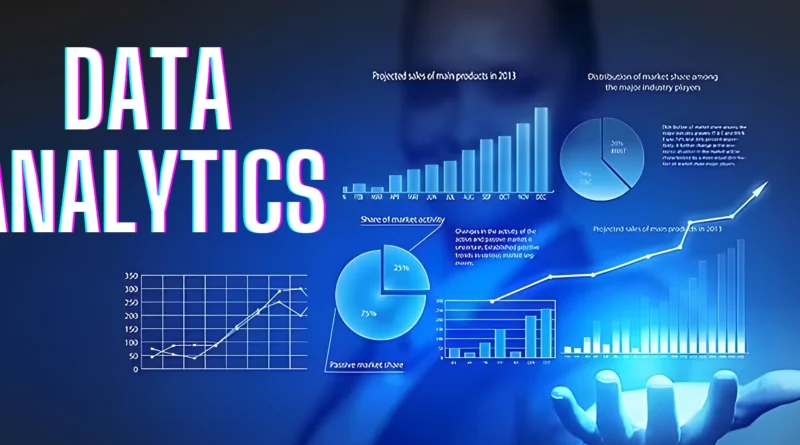How Data Analytics is Revolutionizing Education: Unlocking Power
Unlocking the Power of Data: How Analytics is Revolutionizing Education
The Hidden Potential of Data Analytics in Education
Data analytics is the process of examining large sets of data to extract useful insights. This method has been extensively applied in various industries such as healthcare, finance, and business. In recent years, data analytics has emerged as a game-changer in the field of education.
Education institutions collect massive amounts of data every day including student performance, attendance records, and demographic information. By applying data analytics techniques to this information, educators can gain deeper insights into their students’ academic progress and improve their teaching methods.
The importance of data analytics in education cannot be overstated. With the increasing pressure on educators to deliver high-quality education while managing limited resources, effective use of data analytics can be a real game-changer.
The insights gleaned from analysis can help teachers tailor their lesson plans to individual student needs and identify areas where students may require additional support or intervention. What data analytics actually do? For example, by tracking patterns in student performance over time using advanced data analysis techniques, educators can identify areas where individual students may need additional support or resources before they fall behind.
Additionally, schools and universities can use these insights to optimize resource allocation by identifying areas where funding is needed most and ensuring that teacher training programs are targeting the most effective methods for classroom instruction. By utilizing these tools effectively, educators have an opportunity to revolutionize educational outcomes for millions of students around the world.
The Benefits of Data Analytics in Education
Data analytics is revolutionizing the education sector, providing educators and administrators with valuable insights to improve student outcomes. By harnessing the power of data, schools can identify key areas where improvements are needed and make data-driven decisions to enhance teaching practices, streamline administrative processes, and optimize resource allocation.
Improving Student Performance
One of the primary benefits of data analytics in education is its ability to track student performance and identify areas for improvement. By analyzing test scores, attendance records, and other key metrics, educators can gain a deeper understanding of individual students’ strengths and weaknesses.
This information can be used to personalize learning experiences for each student by tailoring teaching methods to their specific needs. For example, if a student is struggling with math concepts related to algebraic equations, teachers can provide additional resources like one-on-one tutoring sessions or online videos that focus specifically on this topic.
Enhancing Teacher Performance
Another significant benefit of data analytics in education is its ability to provide insights into teacher performance. Educators can use these insights to evaluate their effectiveness in the classroom and identify areas for professional development.
By analyzing data related to student performance on tests or homework assignments, teachers can determine which teaching methods are most effective for different students or groups of students. This information can also be used by administrators when evaluating teacher performance during periodic evaluations.
Optimizing Institutional Operations
Data analytics has immense potential when it comes to streamlining administrative processes in schools. From scheduling classes to budget allocation decisions, every aspect of school administration can benefit from a more data-driven approach.
For instance, schools can use predictive analytics tools that analyze past trends and patterns in enrollment numbers or graduation rates to better plan class schedules for upcoming semesters. Similarly, resource allocation decisions such as budgeting for textbooks or hiring new staff members can be made more efficiently by analyzing historical data on past expenditures and returns.
Predictive Analytics: Identifying At-Risk Students
Predictive analytics uses historical data and statistical algorithms to identify trends, patterns and predict future outcomes. In education, predictive analytics can help identify students who are at risk of dropping out or falling behind in their studies. By analyzing data such as attendance records, grades, test scores, and demographic information, schools can identify students who may need extra support academically or emotionally.
Interventions for at-risk students can include personalized learning plans, additional academic support through tutoring or counseling services, or other interventions designed to address specific needs identified using data analysis. Predictive analytics not only helps schools intervene early with struggling students but also provides students with a greater chance of academic success.
Learning Analytics: Analyzing Student Behavior
Learning analytics involves collecting and analyzing data about student behavior in the classroom to improve teaching methods and learning outcomes. This type of analysis can help educators understand how their teaching methods impact student performance and how different factors like time spent on task affect student engagement. Learning analytics can also assist in identifying areas where additional support may be needed for individual students based on their learning style.
Through the use of learning analytics tools like dashboards that show real-time progress reports on student performance, educators can make informed decisions about how they teach certain subjects or concepts. By analyzing the data collected from these tools, teachers can adjust their teaching methods to better meet the needs of their students while also improving learning outcomes across a broader range of subjects.
Social Network Analysis: Understanding Interactions Between Students
Social network analysis involves examining patterns in social relationships between people or groups. In education settings, social network analysis is used to understand how interactions between students impact academic performance.
By analyzing data such as communication logs between students or social media activity, we can identify patterns in student interactions that contribute to positive or negative academic outcomes. Social network analysis can also be used to identify students who may be struggling due to social isolation or a lack of connections within their peer group.
By understanding the patterns of student interaction, educators can intervene early and provide support where needed. Social network analysis also helps teachers understand how classroom dynamics and social relationships affect learning outcomes, allowing for more informed adjustments in teaching methods and classroom environment.
Challenges and Limitations of Data Analytics in Education
Privacy Concerns
While data analytics has the potential to revolutionize education, there are also valid concerns about privacy. With so much sensitive information being collected, stored, and analyzed, there is always a risk that it could fall into the wrong hands. It is important that schools and institutions take measures to protect student privacy by ensuring that data is encrypted and only accessible to authorized personnel.
Additionally, students and their families should be informed about what data is being collected and how it will be used. Another concern is the potential for discrimination or bias.
If data analytics systems are not designed with diversity in mind, they could end up perpetuating existing inequalities rather than addressing them. For example, if an algorithm identifies certain groups of students as “at-risk” based on past performance data without taking into account factors such as socio-economic status or cultural background, these groups may be unfairly labeled as problematic or less capable.
Technical Challenges
Implementing data analytics systems in education requires significant technical expertise. Schools may need to invest in new hardware or software infrastructure, hire IT professionals with specialized skills, or work with outside vendors to implement a customized solution.
This can be expensive and time-consuming. In addition to technical challenges related to implementation, there are also challenges related to the quality of the data itself.
Data must be reliable and accurate for effective analysis. If data is inconsistent or incomplete, it may lead to inaccurate conclusions or recommendations based on flawed assumptions.
Ethical Considerations
Data analytics raises ethical questions about who owns educational outcomes – students themselves or teachers/institutions? Using analytics may give teachers more power over their students’ lives than they might otherwise have had.
And because much of this power derives from information generated by algorithms rather than human intuition (“machine learning“), educators might feel comfortable making decisions based on analytics that they would be reluctant to make based on their own experience or ethical standards. In addition, there’s a danger of the data becoming an end in itself.
Having access to enormous quantities of data could easily lead institutions to overlook some important but less quantifiable aspects of education, such as the importance of critical thinking, creativity and collaboration skills. It is important for educators to use data analytics as a tool rather than a replacement for traditional teaching methods and assessment techniques, so that the holistic value and purpose of education is never lost.
The Potential of Data Analytics to Transform Education
Benefits of Data Analytics in Education
Data analytics has the potential to revolutionize the way we approach education. With the ability to track student progress and identify areas for improvement, data analytics allows for a more individualized approach to learning.
This can have a significant impact on improving overall student performance, as well as enhancing teacher performance by providing insights into teaching methods and effectiveness. In addition, data analytics can optimize institutional operations by streamlining administrative processes and improving resource allocation.
For example, schools can use data analytics to examine trends in enrollment and course selection, allowing them to make more informed decisions about staffing and curriculum development. Overall, the benefits of data analytics in education are vast and varied, with the potential to transform every aspect of education from curriculum development to student outcomes.
Applications of Data Analytics in Education
There are numerous applications of data analytics in education that have already begun to be implemented in schools across the country. Predictive analytics is one such application that focuses on identifying at-risk students and intervening early to prevent dropouts. By analyzing attendance records, test scores, and other factors that impact academic success, predictive analytics can help educators identify students who may be struggling before it’s too late.
Another application of data analytics is learning analytics which involves analyzing student behavior to improve learning outcomes. By examining patterns in how students engage with course materials and other resources both inside and outside of class time, educators can better understand what’s working well for their students -and what isn’t.
Social network analysis is yet another area where data analytics is being applied within education settings. By examining how students interact with each other both within school walls as well as through online channels like social media platforms – educators gain new insights into how those interactions impact academic performance.
Challenges & Limitations of Data Analytics in Education
Despite the many benefits and applications of data analytics in education, there are also a number of challenges and limitations that must be addressed. One major challenge is privacy concerns.
As schools collect more data about their students, it’s important to ensure that that information is kept confidential and used only for appropriate purposes. Another challenge is technical in nature.
Not all educators have the training or expertise required to effectively analyze large amounts of data -and not all schools have the resources needed to build robust data analytics programs. Ethical considerations are also important since the use of student data raises significant ethical questions about how best to use this information without infringing on individual rights.
Conclusion
Data analytics has enormous potential to transform education. The benefits of using data analytics in education are vast, ranging from improving student performance and enhancing teacher effectiveness to optimizing institutional operations.
Despite challenges posed by privacy concerns, technical constraints and ethical considerations – there’s no denying that leveraging big data has become a key component of modern-day learning environments. With the right approach, emphasis on privacy protection with regard to student records, effective leadership and investment in personnel training it may well soon revolutionize teaching everywhere – leading ultimately towards better outcomes for learners from all walks of life.



